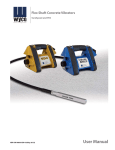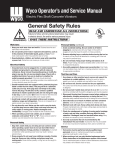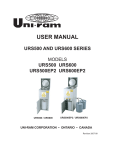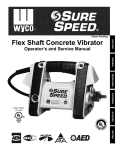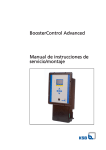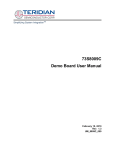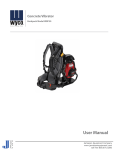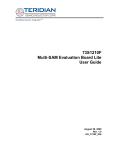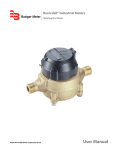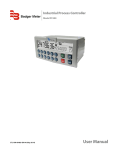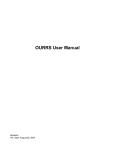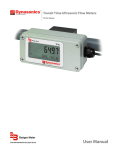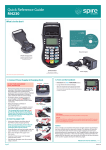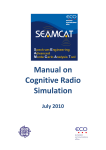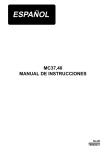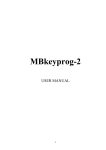Download User Manual - Contractors Direct
Transcript
Flex Shaft Concrete Vibrators SureSpeed and 994 VBR-UM-00043-EN-03 (June 2014) User Manual Flex Shaft Concrete Vibrator Page ii June 2014 User Manual CONTENTS General Power Tool Safety Warnings . . . . . . . . . . . . . . . . . . . . . . . . . . . . . . . . . . . . . . . . . . . . . . . . . . . . . . . . . .5 Work Area Safety . . . . . . . . . . . . . . . . . . . . . . . . . . . . . . . . . . . . . . . . . . . . . . . . . . . . . . . . . . . . . . . . . . . 5 Electrical Safety . . . . . . . . . . . . . . . . . . . . . . . . . . . . . . . . . . . . . . . . . . . . . . . . . . . . . . . . . . . . . . . . . . . . 5 Personal Safety . . . . . . . . . . . . . . . . . . . . . . . . . . . . . . . . . . . . . . . . . . . . . . . . . . . . . . . . . . . . . . . . . . . . .5 Power Tool Use and Care . . . . . . . . . . . . . . . . . . . . . . . . . . . . . . . . . . . . . . . . . . . . . . . . . . . . . . . . . . . . . . .5 Service . . . . . . . . . . . . . . . . . . . . . . . . . . . . . . . . . . . . . . . . . . . . . . . . . . . . . . . . . . . . . . . . . . . . . . . . . .5 Emissions . . . . . . . . . . . . . . . . . . . . . . . . . . . . . . . . . . . . . . . . . . . . . . . . . . . . . . . . . . . . . . . . . . . . . . . . 6 Safety Symbol Explanations . . . . . . . . . . . . . . . . . . . . . . . . . . . . . . . . . . . . . . . . . . . . . . . . . . . . . . . . . . . . . . . 6 Additional Safety Note . . . . . . . . . . . . . . . . . . . . . . . . . . . . . . . . . . . . . . . . . . . . . . . . . . . . . . . . . . . . . . . .6 Introduction . . . . . . . . . . . . . . . . . . . . . . . . . . . . . . . . . . . . . . . . . . . . . . . . . . . . . . . . . . . . . . . . . . . . . . . . . 6 Operation . . . . . . . . . . . . . . . . . . . . . . . . . . . . . . . . . . . . . . . . . . . . . . . . . . . . . . . . . . . . . . . . . . . . . . . . . . .7 Before Starting the Motor . . . . . . . . . . . . . . . . . . . . . . . . . . . . . . . . . . . . . . . . . . . . . . . . . . . . . . . . . . . . . .7 Setup . . . . . . . . . . . . . . . . . . . . . . . . . . . . . . . . . . . . . . . . . . . . . . . . . . . . . . . . . . . . . . . . . . . . . . . . . . . . . .8 Connecting the Vibrating Casing (Quick-Disconnect Connections) . . . . . . . . . . . . . . . . . . . . . . . . . . . . . . . . . . . . . . . . . . . . . . . . . . . . . . . . . 8 Disconnecting the Vibrator Casing (Quick-Disconnect) . . . . . . . . . . . . . . . . . . . . . . . . . . . . . . . . . . . . . . . . . . . . . . . . . . . . . . . . . . . . . . . . . .9 Connecting the Vibrating Casing (Threaded Connections) . . . . . . . . . . . . . . . . . . . . . . . . . . . . . . . . . . . . . . . . . . . . . . . . . . . . . . . . . . . . . . .9 Disconnecting the Vibrator Casing (Threaded Connector) . . . . . . . . . . . . . . . . . . . . . . . . . . . . . . . . . . . . . . . . . . . . . . . . . . . . . . . . . . . . . . . 10 Parts . . . . . . . . . . . . . . . . . . . . . . . . . . . . . . . . . . . . . . . . . . . . . . . . . . . . . . . . . . . . . . . . . . . . . . . . . . . . . 12 Preventive Maintenance . . . . . . . . . . . . . . . . . . . . . . . . . . . . . . . . . . . . . . . . . . . . . . . . . . . . . . . . . . . . . . . . . 12 Brush Removal . . . . . . . . . . . . . . . . . . . . . . . . . . . . . . . . . . . . . . . . . . . . . . . . . . . . . . . . . . . . . . . . . . . . 13 Brush Replacement . . . . . . . . . . . . . . . . . . . . . . . . . . . . . . . . . . . . . . . . . . . . . . . . . . . . . . . . . . . . . . . . . 13 Filter Replacement . . . . . . . . . . . . . . . . . . . . . . . . . . . . . . . . . . . . . . . . . . . . . . . . . . . . . . . . . . . . . . . . . 13 Electric Vibrator Head Service & Maintenance . . . . . . . . . . . . . . . . . . . . . . . . . . . . . . . . . . . . . . . . . . . . . . . . . . . . . . . . . . . . . . . . . 13 Flexible Shaft Lubrication Procedure . . . . . . . . . . . . . . . . . . . . . . . . . . . . . . . . . . . . . . . . . . . . . . . . . . . . . . 14 Extension Cords . . . . . . . . . . . . . . . . . . . . . . . . . . . . . . . . . . . . . . . . . . . . . . . . . . . . . . . . . . . . . . . . . . . 15 Electric Vibrator Head Assembly Drawings & Parts Lists . . . . . . . . . . . . . . . . . . . . . . . . . . . . . . . . . . . . . . . . . . . . . 15 Vibrator Head Model 750-D . . . . . . . . . . . . . . . . . . . . . . . . . . . . . . . . . . . . . . . . . . . . . . . . . . . . . . . . . . . . 16 Vibrator Head Model 750-EH . . . . . . . . . . . . . . . . . . . . . . . . . . . . . . . . . . . . . . . . . . . . . . . . . . . . . . . . . . . 16 Vibrator Head Models 750-FI, 750-GI, 750-LI and 750-MI . . . . . . . . . . . . . . . . . . . . . . . . . . . . . . . . . . . . . . . . . 17 Vibrator Head Model 750-SBI . . . . . . . . . . . . . . . . . . . . . . . . . . . . . . . . . . . . . . . . . . . . . . . . . . . . . . . . . . . 17 Restrictions of Hazardous Substances (Rohs) Directive . . . . . . . . . . . . . . . . . . . . . . . . . . . . . . . . . . . . . . . . . . . . . 18 Waste Electrical and Electronic Equipment (WEEE) Directive . . . . . . . . . . . . . . . . . . . . . . . . . . . . . . . . . . . . . . . . . . 18 June 2014 Page iii Flex Shaft Concrete Vibrator Model Number Serial Number Date Purchased Page iv June 2014 User Manual WARNING READ ALL SAFETY WARNINGS AND ALL INSTRUCTIONS. FAILURE TO FOLLOW THE WARNINGS AND INSTRUCTIONS MAY RESULT IN ELECTRIC SHOCK, FIRE AND/OR SERIOUS INJURY. GENERAL POWER TOOL SAFETY WARNINGS NNOTE: Save all warnings and instructions for future reference. NNOTE: The term power tool in the warnings refers to your mains-operated (corded) power tool or batteryoperated (cordless) power tool. Work Area Safety 1. Keep work area clean and well lit. 2. Do not operate power tools in explosive atmospheres, such as in the presence of flammable liquids, gases or dust. Power tools create sparks which may ignite the dust or fumes. 3. Keep children and bystanders away while operating a power tool. Electrical Safety 1. Power tool plugs must match the outlet. Never modify the plug in any way. Do not use any adapter plugs with earthed or grounded power tools. Unmodified plugs and matching outlets will reduce risk of electric shock. 2. Avoid body contact with earthed or grounded surfaces such as pipes, radiators, ranges, and refrigerators. There is an increased risk of electric shock if your body is earthed or grounded. 3. Do not expose power tools to rain or wet conditions. Water entering a power tool will increase the risk of electric shock. 4. Do not abuse the cord. Never use the cord for carrying, pulling or unplugging the power tool. Keep cord away from heat, oil, sharp edges or moving parts. Damaged or entangled cords increase the risk of electric shock. 5. When operating a power tool outdoors, use an extension cord suitable for outdoor use to reduce the risk of electric shock. 6. If operating a power tool in a damp location is unavoidable, use a residual current device (RCD) protected supply to reduce the risk of electric shock. NNOTE: The term residual current device (RCD) may be replaced by the term ground fault circuit interrupter (GFCI) or earth leakage circuit breaker (ELCB). June 2014 Personal Safety 1. Do not use a power tool while you are tired or under the influence of drugs, alcohol or medication to avoid risk of serious personal injury. 2. Always wear eye protection. Other protective equipment such as dust mask, non-skid safety shoes, hard hat, or hearing protection should be used in appropriate conditions to reduce personal injuries. 3. Ensure the switch is in the OFF position before connecting to power source and/or battery pack, picking up or carrying the tool. 4. Remove any adjusting key or wrench before turning the power tool on. A wrench or a key left attached to a rotating part of the power tool may result in personal injury. 5. Do not overreach. Keep proper footing and balance at all times. 6. Do not wear loose clothing or jewelry. Keep your hair, clothing and gloves away from moving parts. Loose clothes, jewelry or long hair can be caught in moving parts. 7. If devices are provided for the connection of dust extraction and collection facilities, ensure these are connected and properly used. Use of dust collection can reduce dust-related hazards. Power Tool Use and Care 1. Do not force the power tool. Use the correct power tool for your application. 2. Do not use the power tool if the switch does not turn it on and off. Any power tool that cannot be controlled with the switch is dangerous and must be repaired. 3. Disconnect the plug from the power source and/or the battery pack from the power tool before making any adjustments, changing accessories, or storing power tools to reduce the risk of starting the power tool accidentally. 4. Store idle power tools out of the reach of children and do not allow persons unfamiliar with the power tool or these instructions to operate the power tool. 5. Maintain power tools. Check for misalignment or binding of moving parts, breakage of parts and any other condition that may affect operation. If damaged, have the power tool repaired before use. 6. Keep cutting tools sharp and clean. 7. Use the power tool, accessories, tool bits, and like equipment in accordance with these instructions, taking into account the working conditions and the work to be performed. Service Have your power tool serviced by a qualified repair person using only identical replacement parts to ensure the tool is safe to use. Page 5 Flex Shaft Concrete Vibrator Emissions Additional Safety Note 1. Declared noise emission values: K = 0.69 dB LpA = 83.1 dB LWA = 94.1 dB NNOTE: Wear hearing protection. 2. Declared vibrator emissions: Front Handle = 4.28 m/s2 K = 1.50 m/s2 Rear Handle = 2.41 m/s2 K = 1.50 m/s2 NNOTE: The declared vibration total value has been measured in accordance with a standard test method and may be used for comparing one tool with another. The declared vibration total value may also be used in a primary assessment of exposure. Double insulated tools are equipped with a polarized plug (one blade is wider than the other). This plug will fit in a polarized outlet only one way. If the plug does not fit fully in the outlet, reverse the plug. If it still does not fit, contact a qualified electrician to install a polarized outlet. Do not change the plug in any way. Double insulation eliminates the need for the three-wire grounded power cord and grounded power supply system. WARNING THE VIBRATION EMISSION DURING ACTUAL USE OF THE POWER TOOL CAN DIFFER FROM THE DECLARED TOTAL VALUE DEPENDING ON THE WAYS IN WHICH THE TOOL IS USED. SAFETY SYMBOL EXPLANATIONS V Volts A Amperes Hz This concrete vibrator motor is used to power concrete flex shaft vibrators which provide vibration to consolidate freshly poured concrete. The vibration is created by an eccentric (off center) weight within the vibrator head. As the weight spins it forces the head housing to move within the fresh concrete. The continuous head movement agitates the concrete mixture resulting in significantly reduced voids. This motor can be used with any valid Wyco vibrator head and shaft combination. See Table 1: Head and shaft combinations on page 6 or common combinations. Shafts are available in lengths of 2, 5, 7, 10, 14, 20 and 30 feet (0.61, 1.52, 2.13, 3.05, 4.27, 6.1, and 9.14 m). WARNING DO NOT USE NON-APPROVED PARTS. THE USE OF NONAPPROVED PARTS MAY CAUSE A HAZARDOUS CONDITION FOR THE OPERATOR. Vibrator Head Vibrator Shaft Size in. (mm) Model No Length CK Series 13/16 (4.76) 750-D 1 (25.4) 750-EH 2...20 ft (0.61...6.1m) 8900 Class II Tool 1-3/8 (34.92) 750-FI IP Symbol 1-3/4 (44.45) 750-GI 2 (50.8) 750-LI 2-1/4 (57.15) 750-MI 2-1/2 (63.5) 750-SBI 1-3/8 (34.92) 750-FI Hertz Alternating Current IPX4 INTRODUCTION Ground Terminal (Protective Earthing) ON OFF Refer to Instruction Manual Variability in Steps 2...20 ft (0.61...6.1m) 9500 30 ft (9.14 m) Table 1: Head and shaft combinations Figure 1: Safety symbols Page 6 June 2014 User Manual OPERATION Before Starting the Motor DANGER DO NOT USE DAMAGED EQUIPMENT. INSPECT THE VIBRATOR FOR DAMAGE PRIOR TO USING THIS EQUIPMENT. READ, UNDERSTAND AND FOLLOW ALL SAFETY AND MAINTENANCE INSTRUCTIONS IN THIS MANUAL. CAREFULLY CHECK THAT THE POWER CORD HAS NO CUTS OR EXPOSED WIRES. VERIFY MOTOR HOUSING IS INTACT. CHECK ALL ACORN NUTS TO VERIFY THEY ARE TIGHTENED. DANGER DO NOT START THE MOTOR WITHOUT A SHAFT CONNECTED. THE EXPOSED SHAFT CONNECTION PRESENTS A SAFETY HAZARD AS IT ROTATES AT HIGH SPEED. CLOTHING OR SKIN MAY BECOME ENTANGLED IN THE SHAFT CONNECTION CAUSING INJURY. Ensure that the motor, shaft and head are connected securely. See Preventive Maintenance on page 12. Ensure that the power plug is connected to the appropriate power source. Ensure that the motor is not immersed in concrete and that any cord connections are not in water or fresh concrete. Turn vibrator on by moving the rocker switch to I. See Table 3: Concrete vibrator replacement parts on page 12 for switch location. NNOTE: The Sure Speed has been designed with a soft start and will slowly ramp up to speed over a 1 second period. Insert the vibrator head into the concrete to be consolidated. Do not run the vibrator head outside of fresh concrete for an extended period of time. The vibrator depends on moving concrete to cool the bearings. Avoid sharp bends in the flex shaft during operation. Sharp bends reduce shaft life. Remove the vibrator head from concrete and turn the rocker switch to O. See Table 3: Concrete vibrator replacement parts on page 12 for switch location. June 2014 Variable Speed Control Models Only The variable speed option allows the operator to choose between 8000, 10,500, and 12,000 VPM (vibrations per minute). NNOTE: This instruction only pertains to model numbers that start with WV. NNOTE: See “Concrete vibrator replacement parts” on page 12 for switch and button locations. When the power switch is turned on, the motor will always start at 10,500 VPM. From the time the power is applied there is a 20 second window in which to choose one of the alternate motor speeds. Hold the speed control button for one second to change the motor speed to 8000 VPM. Release the speed control button and then press it again for one second to increase the motor speed to 12,000 VPM. Release and then press the speed control button a third time for one second to return the motor to 10,500 VPM. To reset the 20 second speed change period, turn the power switch off and then on again. Speed Control Button Held for At Least 1 sec 1 sec Ramp-up 12,000 Speed Control Button Held for At Least 1 sec 10,500 Power Switch Turned ON Speed Control Button Held for At Least 1 sec VPM 8000 7000 20 sec Figure 2: Variable speed control timing Page 7 Flex Shaft Concrete Vibrator SETUP The motor has several options for connecting the core and casing assembly to the motor housing. For all available connections, see Figure 13 “Core and casing configurations” on page 11. UnLocked Locked Figure 5: Unlock/Lock icons Connecting the Vibrating Casing (Quick-Disconnect Connections) NNOTE: The casing must be fitted with a quick‑disconnect end. Shaft Figure 6: Core/Casing alignment Locking Lever Figure 3: Quick‑disconnect fitting 1. Be sure the locking lever on the quick‑disconnect connector on the motor is in the up position. See Figure 3. 2. Locate the core and casing. Identify the side of the casing that has the connection arrow and position the casing with the arrow face to the left as viewed from the vibrator head end. See Figure 4. This side should face to the left when the casing is held directly behind the quick‑disconnect. 5. Insert the casing and line up the shaft and driver so the shaft slides into the driver. 6. Rotate the casing until the arrow lines up with the lock icon on the quick‑disconnect connector. 7. Push down on the locking lever to clamp the casing into the quick‑disconnect connector. The locking lever should bottom out on the side of the quick‑disconnect connector. NNOTE: If the casing feels loose or too tight after pushing down on the locking lever, raise the lever until the lever is horizontal then rotate the hex head screw with a #4 Allen wrench in either direction to tighten or loosen. Be careful to not loosen the lever too far or the lever bushing and screw will unthread and could fall apart. After the adjustments are completed, push lever back down to bottom out to connector. This procedure may need to be repeated to get desired tight or lose condition. See Figure 7. Figure 4: Casing arrow location 3. Align the end of the core with the driver inside the quick‑disconnect fitting on the motor. 4. Align the arrows on the casing end with the unlock icon on the quick‑disconnect connector. The unlock and lock positions are shown by the unlock and lock icons (see Figure 5) on the side of the quick‑disconnect fitting. See Figure 6. Page 8 June 2014 User Manual Connecting the Vibrating Casing (Threaded Connections) NNOTE: The casing must be fitted with a thread connector end. Locking Lever Figure 7: Locking lever adjustment Disconnecting the Vibrator Casing (Quick-Disconnect) 1. Be sure the quick‑disconnect locking lever on the motor is in the up position. 2. Rotate the core and casing counterclockwise from the lock position to the unlock position. 3. Pull the casing end straight out of the quick‑disconnect connector on the motor. 4. Be sure that the locking lever is in the down position when storing the motor to avoid damage to the lever. Figure 8: Threaded casing connector 1. Line up threads of the shaft with the threaded motor connector. Hold the casing end firmly and rotate the casing until it engages into the motor. Threads Shaft Figure 9: Shaft insertion 2. Hold the casing assembly in one hand while carefully rotating the motor counterclockwise until motor is snug to the shaft. See Figure 10. June 2014 Page 9 Flex Shaft Concrete Vibrator Disconnecting the Vibrator Casing (Threaded Connector) 1. Carefully loosen the hex motor connector, using a crescent wrench on the motor and a pipe wrench on the flex shaft assembly, until the motor assembly can be rotated by hand in a counterclockwise direction. See Figure 11. R o t ati o n Figure 12: Hex motor connection Figure 10: Motor rotation NNOTE: The motor may be taken off of the work surface allowing the motor housing to spin in the air while holding onto the flex shaft with a hand or with vise. Do not over tighten or reef as this may damage the plastic motor housing. 4. Once threads are started, rotate motor assembly until the motor assembly stops turning. See Figure 10. 5. Use a crescent wrench to hold the hex motor connector and a pipe wrench on the flex shaft to tighten. See Figure 11. 2. Carefully rotate the motor until it and the casing separate from one another. Do not pull the core end too far out of the casing end or the head will have to be removed to realign the core with the head driver. 3. Place casing end of shaft into a vice and place an adjustable wrench to the hex motor connector to tighten the motor to shaft. WARNING TIGHTENING OR TORQUING USING THE MOTOR HANDLE CAN CAUSE DAMAGE TO MOTOR CASING. The motor can accommodate any of the 750 series cores and casings. The motor is ordered as either a dedicated quick‑disconnect connection or a dedicated threaded connection version. If the threaded version was ordered it cannot be used with the quick‑disconnect core and casing. If the quick‑disconnect version was ordered threaded core and casings can be used with the addition of a thread to quick‑disconnect adapter. The configuration options are shown in Figure 13. Figure 11: Crescent wrench and pipe wrench placement 6. The vibrator assembly is now ready to use. Page 10 June 2014 User Manual 5 3 4 1 5 2 Figure 13: Core and casing configurations Item Description 1 Quick-Disconnect Motor End 2 Threaded Motor End 3 Threaded to Quick-Disconnect Adapter 4 Quick-Disconnect Core and Casing 5 Threaded Core and Casing Notes These motor ends are part of the motor assembly. They are not interchangeable and are part of the specific part number. Wyco PN W423-500 allows threaded core and casings to be used with quick‑disconnect motor. Table 2: Core and casing options June 2014 Page 11 Flex Shaft Concrete Vibrator PARTS Item Description Quantity WVD1 WVG1 WSD1 1 D-Ring 2 W819014 2 Filter, Intake 1 W423132 3 Carriage Screw; 10-32, 3/4 in (19.05 mm) 9 W423140 4 Acorn Nut, Self-locking; 10-32 UNF 9 W423141 5 Assembly, Brush & Spring; 115 V AC 2 W423117 5 Assembly, Brush & Spring; 230 V AC 2 6 Brush Cap with O-Ring 2 W423114 7 Casing Connector 8 Variable Speed Switch 514-O Non-foaming Vibrator Oil 14 oz W655-143 Strap, Carry (not shown) 1 W819013 514-B Shaft Lubricant 14 oz W655-140 Permatex 11 oz W657055 See Figure 14 for parts locations WSG1 WSG2 W819014 W423132 W423140 W423141 W423118 W423114 W655-143 W819013 W655-140 W657055 Table 3: Concrete vibrator replacement parts 4 1 6 8 5 7 3 5 6 2 Figure 14: Parts locations PREVENTIVE MAINTENANCE Wyco vibrator motors are designed to operate 50…100 hours between normal preventive maintenance intervals. The service instructions below should be followed to perform the preventive maintenance. WARNING THERE ARE NO USER SERVICEABLE PARTS CONTAINED WITHIN THE MOTOR HOUSING. OPENING THE MOTOR HOUSING MAY BE DANGEROUS AND WILL VOID THE WARRANTY. ANY REPAIRS THAT REQUIRE OPENING THE MOTOR HOUSING SHOULD BE PERFORMED AT AN AUTHORIZED Wyco SERVICE CENTER OR AT THE Wyco FACTORY. USE ONLY FACTORY AUTHORIZED REPLACEMENTS PARTS. Page 12 June 2014 User Manual Brush Removal For the location of the parts used in the following procedures see Figure 14 and Table 3. 1. Disconnect the line cord from the power source. 2. Lay the motor on its side with the brush cap (6) facing up. 3. Use a 1/2 in 6-sided socket to unscrew the plastic brush cap (6) from the motor half. 4. The brush spring (5) will pop out. Carefully remove the brush spring by gently pulling on the spring. 5. Repeat these steps for the opposite side. Brush Replacement NNOTE: Brushes should be replaced in pairs. 1. Inspect and replace damaged O-rings. 2. Lubricate the O-ring prior to cap installation 3. Align the new brush (5) with brush holder. Insert the new brush. 4. Push the spring into the holder as you screw the brush cap back into the housing. NNOTE: The O-ring must be on the brush cap before you screw the cap into the housing. 5. Torque the brush cap (6) to 35 in. lb. 6. Repeat these steps for the opposite side. Figure 15: End cap removal 2. Pull the eccentric rotor assembly out of the housing. If the bearings are stuck and you have difficulty removing them from the housing, screw the end cap partly back into the housing and bounce the head and cap down on a block of wood in order to loosen the bearings from their seat, then pull out the rotor assembly. See Figure 16. Filter Replacement 1. Pull the old filter down from the housing with your fingers. 2. Place the new filter (2) in the housing, tapered side up. See Figure 14. ELECTRIC VIBRATOR HEAD SERVICE & MAINTENANCE Figure 16: Bearing Removal IIMPORTAN Service the vibrator head after every 50 hours of operation for trouble-free running on the job. When servicing, always replace the hex driver, the seals and the bearings, or bushing for 750-D & 750-EH heads. See Electric Vibrator Head Assembly Drawings & Parts Lists on page 15. All heads are equipped with seals at the flexible shaft end and contain oil. The seals serve a double purpose; to keep the oil in the head and to keep the grease from the flexible shaft out of the head. 1. Hold the nose end in a vise and unscrew the end cap counterclockwise with a chain wrench or a good pipe wrench. See Figure 15. June 2014 NNOTE: Hexagon driver has left hand threads. 3. Flush the rotor assembly and housing with solvent and wipe all parts clean. Replace bearings, seals and hex driver. Maintain concentric alignment of the hex driver with respect to the rotor shaft. Refill with proper amount of Wyco No. 514-O non-foaming vibrator oil. See Table 4. Apply Loctite 545 adhesive/sealant or equivalent to threads on both ends of rotor. Page 13 Flex Shaft Concrete Vibrator Head Model 750-D 750-EH 750-FI 750-GI 750-LI 750-MI 750-SBI Head Size in (mm) 13/16 (20.64) Square 1 (25.4) Square 1-3/8 (34.93) Square 1-3/4 (44.45) Square 2 (50.8) Square 2-1/4 (57.15) Square 2-1/2 (63.5) Round Oil Required 1/2 oz (14 g) 3/4 oz (21 g) 1 oz (28 g) 1-1/4 oz (35 g) 2 oz (57 g) 3-1/2 oz (99 g) 1-1/4 oz (35 g) Table 4: Head oil requirements 4. Replace the rotor assembly into the head housing. Apply Loctite 545 adhesive/sealant or equivalent all around the threads of the end cap. Tighten and wipe off excess Loctite 545 adhesive/sealant. Flexible Shaft Lubrication Procedure A break-in procedure is required after the assembly of separately shipped core and casing. This procedure involves repeatedly coiling the flex shaft from the head to the motor while the motor is running. The coiling and uncoiling should be repeated at least three times for proper break-in. NNOTE: For shorter core and casing combinations, coiling is not possible. Break-in for short core and casings requires bending into a U-shape instead of a coil. Water is one of the greatest enemies of satisfactory performance of vibrator heads. As the head is submerged in the mix, water and cement can infiltrate into the head unless precautions are taken. In addition to securely tightening the head onto the flexible shaft, the threads on the head and shaft must be coated with Permatex Form-A-Gasket No. 2. This must be done each and every time that the head is removed and reinstalled. When vibrators are shipped completely assembled from the factory, the shafts are lubricated and broken-in. If separate cores and casings are shipped, they require the following lubrication and break-in procedure. Core and casing combinations should be checked for lubricant levels at least every 50 hours. To lubricate, lightly coat the core with grease (Wyco 514-B shaft lubricant) while inserting it into the casing. Do not over lubricate. Surplus lubricant may get past the seal in the vibrator head. Over lubrication will also increase the amount of torque required to operate the vibrator, resulting in additional stress on the motor and possibly early core and casing failure. When adding lubricant on the job, after each 50 hours of operation, loosen the casing from the motor and pull out the core about 15…18 inches (318.... 457.2 mm). Apply lubricant as above to the exposed section of core. Reinstall the core, making sure that it engages with the vibrator head. During operation, the grease will travel the full length of the casing. Page 14 June 2014 User Manual Extension Cords When selecting an extension cord for use with Wyco electric motor cord sets using a three-prong polarized plug, an equivalent plug set must be used for the grounded or earthed version. IIMPORTAN A grounded or earthed motor requires a grounded or earthed extension cord. A two-prong extension cord may be used for the double insulated motor. Extension cords must be approved for outdoor use and the wire gauge of the cord must be appropriate for the expected load. See Table 5. Motor Type Voltage Rated Amps Minimum Wire Size Maximum Cord Length 14 AWG 100 ft (30.48 m) 12 AWG 150 ft (45.72 m) 16 AWG 100 ft (30.48 m) 14 AWG 150 ft (45.72 m) 16 AWG 100 ft (30.48 m) WSD1 WSD1T WSG1 WSG1T W994D1 W994D1T W994G1 115 V AC(±15V AC) 15 W994G1T WVD1 WVD1T WVG1 WVG1T WSG2 WSG2T WVG2 WVG2T 230 V AC (±30V AC) 7.5 W994G2 W994G2T Table 5: Extension cord wire minimum size requirements ELECTRIC VIBRATOR HEAD ASSEMBLY DRAWINGS & PARTS LISTS Vibrator Head Model 750-D 750-EH 750-FI Square Marking on End Cap Size in. (mm) D 3/16 (4.76) EH 1 (25.4) 1.38B 1-3/8 (34.92) Assembly Part No Vibrator Head Model W877-520 W877-526 W878-533 750-GI 750-LI 750-MI Square Marking on End Cap Size in. (mm) 1.75B 1-3/4 (44.45) 2.00B 2 (50.8) 2.25B 2-1/4 (57.15) Assembly Part No W878-540 W878-563 W878-568 Table 6: Electric vibrator head models NNOTE: Vibrator head model 750-SBI is a 2-1/2 in (63.5 mm) round head with no end cap marking. Assembly PN is # W877-512. June 2014 Page 15 Flex Shaft Concrete Vibrator Vibrator Head Model 750-D 1 2 3 2 4 5 6 7 8 9 LOCTITE 545 LOCTITE 545 PERMATEX #2 Figure 17: Model 750-D parts Item Description Quantity Part No. Item 1 2 Nut, Hex Jam Bearing, Ball Housing, Square Rotor O-Ring, Buna 1 4 W435638 W097011 6 7 Holder, Seal Seal, Oil 1 W587320 8 Bushing 1 1 W717340 3 4 5 * Description Quantity Part No. 1 2 1 * * * 9 Driver, Hex 1 W382428 * All of these items available assembled in a kit, PN W747-540. Table 7: Model 750-D parts list Vibrator Head Model 750-EH 1 2 3 2 4 LOCTITE 545 5 6 8 7 LOCTITE 545 PERMATEX #2 Figure 18: Model 750-EH parts Item Description Quantity Part No. Item 1 2 Nut, Hex Jam Bearing, Ball Housing, Square Rotor Seal, Oil 1 4 W432710 W097012 6 7 1 W587325 8 1 2 W717345 3 4 5 ** Description Quantity Part No. Bushing End Cap 1 1 W177325 Driver, Hex 1 W384447 ** ** End cap assembly with seals is PN W207-248. (Order bushing separately.) Table 8: Model 750-EH parts list Page 16 June 2014 User Manual Vibrator Head Models 750-FI, 750-GI, 750-LI and 750-MI 1 2 10 3 4 10 5 3 6 8 9 PERMATEX #2 LOCTITE 545 LOCTITE 545 LOCTITE 545 7 Figure 19: Model 750-FI, GI, LI and MI parts Item Description Part No. for Part No. for 750-FI (1.38B) 750-GI (1.75B) W432708 W887015 W096013 W096010 W588331 W588339 W718357 W718335 W887015 Quantity Part No. for Part No. for 750-LI (2.00B) 750-MI (2.25B) W432707 W887011 W096011 W096020 W588354 W588368 W717360 W718365 W887016 1 Nut, Hex Jam 1 2 Washer, Flat 1 3 Bearing, Ball 4 4 Housing, Square 1 5 Rotor 1 6 Washer, Flat 1 7 Seal, Oil 2 *** 8 End Cap 1 *** 9 Driver, Hex 1 W384446 10 Shim 2 W419701 N/A *** Manufacturer suggests using end cap with pressed in seals: 1.38B - PN W208-231; 1.75B - PN W208-236; 2.00B - PN W208-261; 2.25B - PN W208-268. However, seal and end cap are available separately upon request. Table 9: Models 750-FI, 750-GI, 750-LI and 750-MI parts list Vibrator Head Model 750-SBI 2 1 3 4 5 3 6 7 8 9 Figure 20: Model 750-SBI parts Item Description Quantity Part No. Item 1 2 3 4 5 Screw, Hex Socket Washer, Flat Bearing, Ball Rotor Housing 1 1 2 1 1 W437510 W887017 W099910 W717310 W587310 6 7 8 9 Description Washer, Spacer Driver, Hex End Cap Seal, Oil Quantity Part No. 1 1 1 2 W887018 W384446 W207268 W747504 Table 10: Model 750-SBI parts list June 2014 Page 17 Flex Shaft Concrete Vibrator RESTRICTIONS OF HAZARDOUS SUBSTANCES (ROHS) DIRECTIVE This product is compliant with the RoHS Directive identified on the Declaration of Conformity associated with this product. This product does not contain lead, mercury, cadmium, hexavalent chromium, polybrominated biphenyls or polybrominated diphenyl ethers in quantities exceeding the following maximum concentration value levels: Lead 0.1% by weight in homogenous materials Mercury 0.1% by weight in homogenous materials Hexavalent Chromium 0.1% by weight in homogenous materials Polybrominated Biphenyls (PBB) 0.1% by weight in homogenous materials Polybrominated Diphenyl Ethers (PBDE) 0.1% by weight in homogenous materials Cadmium 0.01% by weight in homogenous materials WASTE ELECTRICAL AND ELECTRONIC EQUIPMENT (WEEE) DIRECTIVE In the European Union, this label indicates that this product should not be disposed of with household waste. It should be deposited at an appropriate facility to enable recovery and recycling. For information on how to recycle this product responsibly in your country, please visit: www.badgermeter.com Page 18 June 2014 User Manual June 2014 Page 19 ® A S C C Trademarks appearing in this document are the property of their respective entities. Due to continuous research, product improvements and enhancements, Badger Meter reserves the right to change product or system specifications without notice, except to the extent an outstanding contractual obligation exists. © 2014 Badger Meter, Inc. All rights reserved. [email protected] | www.wycotool.com Phone: 262-639-6770 | Fax: 262-639-2023 Wyco Tool | 8635 Washington Avenue | Racine, WI 53406-3738 USA Legacy Document Number: 01-VBR-UM-00379-EN




















